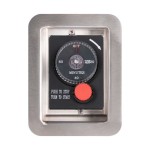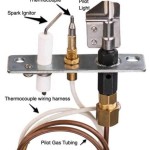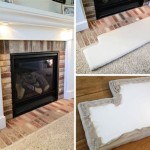How to Install a Solid Wood Fireplace Mantel
Installing a solid wood fireplace mantel can significantly enhance the aesthetic appeal of a living room or family room. A substantial piece of solid wood adds warmth, character, and a focal point to the fireplace. However, due to the weight and material characteristics of solid wood, proper installation is crucial for safety and longevity. This article provides a comprehensive guide to installing a solid wood fireplace mantel, covering preparation, measurement, mounting techniques, and finishing touches.
Preparing for Installation
Before commencing the installation process, several preparatory steps are necessary to ensure a successful outcome. These steps include material selection, surface evaluation, acquiring necessary tools, and understanding local building codes.
Choosing the right solid wood for the mantel is paramount. Different wood species offer varying degrees of hardness, grain patterns, and color tones. Popular choices include oak, maple, walnut, and cherry. Consider the existing décor of the room when selecting the wood species to ensure a cohesive and harmonious design. The dimensions of the mantel should also be carefully considered. Measure the width of the firebox opening and the desired overhang on either side. A mantel that is too small will appear insignificant, while a mantel that is too large can overwhelm the fireplace.
The surface upon which the mantel will be mounted must be thoroughly inspected. The surface should be structurally sound, level, and free from any loose debris or damage. If the surface is uneven, repair or level it before proceeding with the installation. For brick or stone fireplaces, ensure that the mortar joints are in good condition. If the mantel will be affixed to drywall, it is essential to locate the studs behind the drywall and use appropriate fasteners to ensure adequate support. Failure to address the surface condition can compromise the stability and safety of the installed mantel.
A comprehensive toolkit is essential for a smooth and efficient installation. Necessary tools include a measuring tape, level, stud finder, drill with appropriate drill bits (masonry bits for brick or stone, wood bits for wood framing), a socket wrench set, construction adhesive, shims, safety glasses, and a dust mask. A laser level can be particularly useful for ensuring accurate alignment. A helper is also highly recommended, especially when handling heavier mantels.
Prior to commencing the installation, it is prudent to consult local building codes and regulations regarding fireplace mantel installations. These codes often specify minimum clearance requirements between the mantel and the firebox opening, as well as requirements for fire-resistant materials. Adhering to these codes is crucial for ensuring the safety of the installation and avoiding potential fire hazards.
Mounting Techniques for Solid Wood Mantels
Selecting the appropriate mounting technique is critical for securing the solid wood mantel to the fireplace surround. The choice of mounting technique depends on the type of fireplace surround (brick, stone, drywall, or wood) and the weight of the mantel.
For brick or stone fireplaces, one common method involves using masonry screws or anchors. This method requires drilling pilot holes into the brick or stone at the desired mounting locations. Ensure the holes are deep enough to accommodate the screws or anchors. The screws or anchors should be of sufficient length and diameter to provide adequate holding power. Before inserting the screws or anchors, apply a bead of construction adhesive to the back of the mantel to further enhance the bond between the mantel and the fireplace surround. Exercise caution when drilling into brick or stone to avoid cracking or damaging the surrounding material.
Another method for brick or stone fireplaces involves using a French cleat system. A French cleat consists of two interlocking pieces of wood or metal, one mounted to the back of the mantel and the other mounted to the fireplace surround. The cleat attached to the mantel slides down onto the cleat attached to the wall, creating a strong and secure connection. This method allows for easy removal of the mantel if necessary. When installing a French cleat system on a brick or stone fireplace, use masonry screws or anchors to secure the cleat to the surround.
For drywall fireplaces, it is imperative to locate the wall studs behind the drywall. The mantel must be securely anchored to the studs to provide sufficient support. Use a stud finder to locate the studs and mark their positions. Drill pilot holes through the drywall and into the studs. Use lag screws or heavy-duty wood screws to attach the mantel to the studs. If the mantel is particularly heavy, consider adding additional support by installing a ledger board between the studs. The ledger board provides a broader surface area for the mantel to rest upon. Apply construction adhesive to the back of the mantel before attaching it to the studs to further enhance the bond.
For wood fireplaces, mounting the mantel is generally simpler, as wood screws can be used to directly attach the mantel to the wood framing. Ensure that the screws are of sufficient length and diameter to provide adequate holding power. Pre-drilling pilot holes is recommended to prevent the wood from splitting. As with other mounting techniques, applying construction adhesive to the back of the mantel will further enhance the bond.
Regardless of the mounting technique used, it is essential to use shims to ensure that the mantel is level. Place shims between the mantel and the fireplace surround as needed to achieve a perfectly level installation. Once the mantel is level, trim any excess shims with a utility knife.
Finishing Touches and Safety Considerations
Once the mantel is securely mounted, several finishing touches can be applied to enhance its appearance and ensure its longevity. These include filling nail holes, applying a sealant or finish, and ensuring proper clearance from the firebox.
After the mantel is mounted, inspect it for any nail holes or imperfections. Fill these holes with wood filler that matches the color of the wood. Allow the wood filler to dry completely before sanding it smooth with fine-grit sandpaper. Once the wood filler is sanded, apply a sealant or finish to protect the wood from moisture and scratches. Popular choices include polyurethane, varnish, and lacquer. Follow the manufacturer's instructions for application and drying times. Several coats may be necessary to achieve the desired level of protection and sheen.
Maintaining proper clearance between the mantel and the firebox opening is crucial for safety. Most building codes specify minimum clearance requirements to prevent the mantel from overheating and potentially catching fire. Consult local building codes for specific clearance requirements in the area. If the mantel is too close to the firebox, consider installing a heat shield to protect the mantel from excessive heat. A heat shield is a non-combustible barrier that is placed between the mantel and the firebox to deflect heat away from the mantel.
Regular maintenance is essential for preserving the beauty and integrity of the solid wood fireplace mantel. Dust the mantel regularly with a soft cloth to remove dirt and debris. Avoid using harsh chemicals or abrasive cleaners, as these can damage the finish. Inspect the mantel periodically for signs of cracking, warping, or damage. Address any issues promptly to prevent them from worsening. For example, small cracks can be filled with wood filler, while larger cracks may require professional repair. Reapply the sealant or finish as needed to maintain the wood's protection and appearance. Consider using a fireplace screen to prevent embers from damaging the mantel. A fireplace screen also provides an additional layer of safety by preventing sparks from escaping the firebox.
By following these steps carefully, anyone can successfully install a solid wood fireplace mantel and enjoy the beauty and warmth it brings to their home. Remember to prioritize safety, adhere to building codes, and take the time to do the job right. The result will be a stunning focal point that enhances the ambiance of living spaces for years to come.

Fireplace Mantel Installation Tips

Fireplace Mantels Installation Care Redwood Burl Inc

How To Install A Floating Mantle The Easy Way In Just One Afternoon

How To Install A Wood Mantel On Masonry Fireplace Remodelaholic

Fireplace Mantel Installation Before And After

Fireplace Mantel Installation Before And After

How To Install A Fireplace Mantel

How To Install A Floating Mantle The Easy Way In Just One Afternoon

How To Install A Mantel On Brick Fireplace 1905 Farmhouse

Guidelines For Installing Our Rustic Solid Wood Beam Mantels
Related Posts








